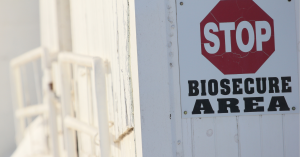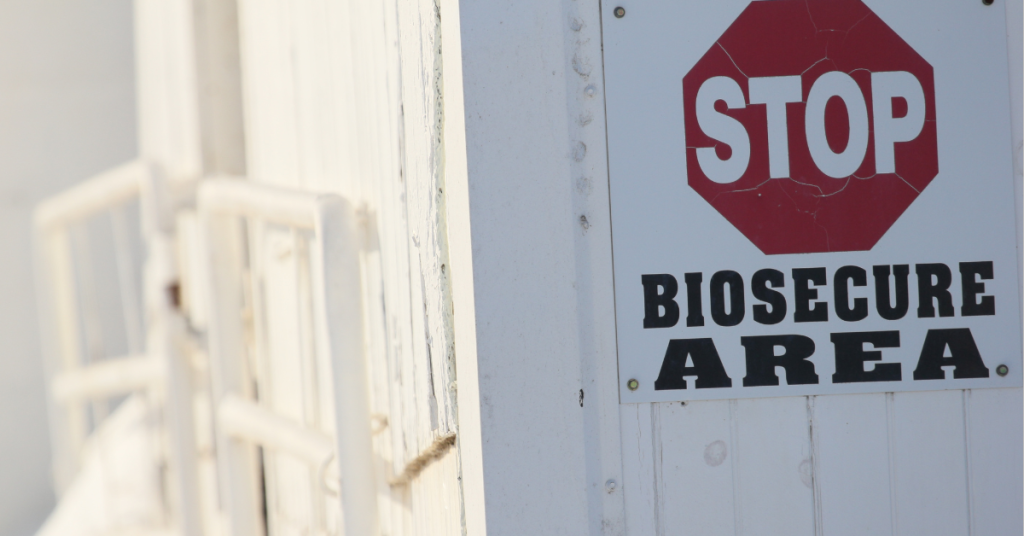
The Center for Dairy Excellence hosted a special edition of its monthly “Protecting Your Profits” webinar on Wednesday, July 26. Dr. Hayley Springer of Penn State Extension shared how the dairy industry can begin to prepare for a potential outbreak of high-consequence animal diseases and the value this preparation can have in the face of a biosecurity crisis.
“When talking about biosecurity, everyone needs to be involved and informed,” Springer said. “Farms with an approved enhanced biosecurity and continuity of business plan will be at the front of the line for permits to then continue doing business in the face of an outbreak.”
Biosecurity plans are a key component of any dairy operation for the protection they provide. Learn more about how to create and execute an everyday biosecurity plan on your dairy operation.
Everyday Biosecurity
Who?
It is important to identify who sets foot on your dairy. Everyday biosecurity is for everyone to play a part in — from owners, employees, and managers who are routinely on the operation to consultants and visitors dropping off a package. Everyday biosecurity involves the biosecurity protocols that every dairy team should have in place and utilize on a routine basis.
What?
By looking at how diseases can enter the herd, we can better identify ways to stop those processes.
“An important aspect of understanding biosecurity practices is to understand how diseases spread,” Springer explained.
Knowing how diseases spread can also help us understand everyday biosecurity practices. For example:
- Vector Born Disease: Carried in a host animal (Ex: ticks > Theileria)
- Iatrogenic Transmission: Humans transmitting the disease (Ex: reuse of needles > Anaplasmosis)
- Direct Contact: Between animals (Ex: BVD)
- Oral: Fecal-oral is the most common transmission of disease (Ex: E. coli, scours)
- Aerosol (Ex: BRD)
- Fomite: Any inanimate object that transmits disease (Ex: boots > salmonella)
- Reproductive (Ex: IBR)
Why?
Dr. Springer referenced a Colorado dairy farm as an example to show the importance of having an everyday biosecurity plan. The farm put in a new facility, including a 60-cow rotary and separate parlor for hospital/fresh cows. This expansion meant growing the milking herd from 350 to 2,500 cows. Cows and heifers were purchased from 15 sources. Each source tested negative for Mycoplasma on a single bulk tank culture. It was noted that one culture is not sufficient for a true reading and several cultures should have been taken.Individual cows were cultured only at freshening or in a clinical case. As a result, the farm was faced with 560 new Mycoplasma mastitis cases in the first 17 months after the expansion. 88% of this group had previous visits to the hospital pen with negative cultures. Multiple calves were displaying respiratory disease, swollen joints, drooping ears, and head tilts. Four quarts of raw colostrum were given within four hours of birth, and then calves were fed pasteurized waste milk.
What was the cost of the outbreak? Milk cultures cost the farm $100,000. Additionally, there was increased culling, added labor for the hospital pen, more discarded milk, calf losses, and reduced average daily gain in calves. According to Dr. Springer, while many of these circumstances cannot be labeled with a specific price, they were certainly costly to the dairy.

How?
When creating and executing an everyday biosecurity plan, it is necessary to identify risks and gaps within the operation that will then drive the development of your protocols. People are the most important component for executing a biosecurity plan in order to reduce the risk of disease transmission. Personnel must be informed of the protocols and understand how to use them properly and effectively.
“We can see that building a good protocol and making sure that people are trained can have a huge impact on everyday biosecurity,” Springer added.
For the dairy in Colorado, they identified transmission pathways that the mycoplasma was spreading (direct contact, oral, aerosol and fomite). Employees were trained on what mastitis is, how it spreads, how to recognize it, methods to prevent spreading during milking, proper treatment techniques, and milking machine disinfection. The operation was faced with 1-2 cases of Mycoplasma per day before the training. After the employees were trained in this area, case numbers dropped to 1-2 cases per month.
Their calf health also improved because of the biosecurity plan and training. The calves were fed heat-treated colostrum. Employees were trained to recognize early signs of respiratory disease, and sick calves were moved to outdoor hutches to reduce the risk of aerosol transmission.
To expand on everyday biosecurity, Dr. Springer also talked about enhanced biosecurity and its importance. A heightened biosecurity plan, approved by state officials, would speed up the acquisition of a permit in the face of a high-consequence animal disease outbreak.
Click here to view an Everyday Biosecurity Manual from the National FARM Program for more resources.

